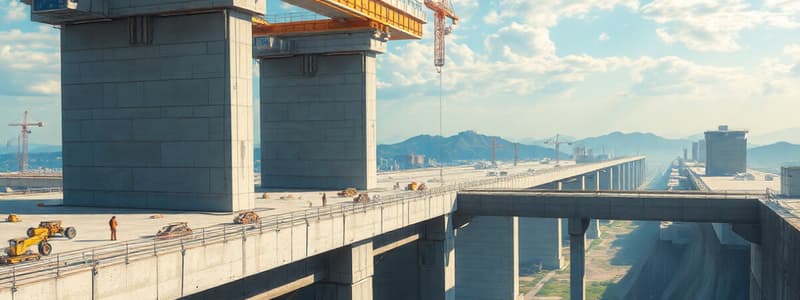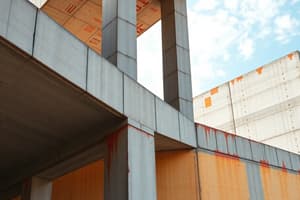Podcast
Questions and Answers
Which of the following is NOT an advantage of prestressed concrete over reinforced concrete?
Which of the following is NOT an advantage of prestressed concrete over reinforced concrete?
- Increased spans
- Increased durability (correct)
- Smaller deflections
- Smaller section sizes
What is the main benefit of prestressed concrete having a larger second moment of area?
What is the main benefit of prestressed concrete having a larger second moment of area?
- Increased durability
- Reduced tensile stress
- Smaller deflections (correct)
- Increased compressive strength
In what scenario is the compressive stress in prestressed concrete maximized?
In what scenario is the compressive stress in prestressed concrete maximized?
- When tendons are stressed before casting (correct)
- When tendons are stressed simultaneously with casting
- When tendons are stressed after casting
- When tendons are stressed before and after casting
Why can a given section span further with prestressed concrete compared to reinforced concrete?
Why can a given section span further with prestressed concrete compared to reinforced concrete?
What is the key difference between pre-tensioned and post-tensioned concrete?
What is the key difference between pre-tensioned and post-tensioned concrete?
Which of these statements accurately describes pre-tentioned concrete?
Which of these statements accurately describes pre-tentioned concrete?
Who first proposed the idea of prestressing to counteract stresses due to loads?
Who first proposed the idea of prestressing to counteract stresses due to loads?
What significant development occurred in 1907 regarding prestressed concrete?
What significant development occurred in 1907 regarding prestressed concrete?
In what year did Dischinger demonstrate the use of unbonded tendons?
In what year did Dischinger demonstrate the use of unbonded tendons?
What was a major problem encountered with early prestressed concrete slabs in the mid-1950s?
What was a major problem encountered with early prestressed concrete slabs in the mid-1950s?
Which company was associated with the manufacture of slabs using embedded tensioned wires in 1888?
Which company was associated with the manufacture of slabs using embedded tensioned wires in 1888?
What was a key result of Jackson's patent application in 1886?
What was a key result of Jackson's patent application in 1886?
What does the US building post-tensioning industry credit for its existence?
What does the US building post-tensioning industry credit for its existence?
What issue arose due to flexural creep in early prestressed concrete slabs?
What issue arose due to flexural creep in early prestressed concrete slabs?
Which development was associated with the introduction of tensioning in the construction of pavements?
Which development was associated with the introduction of tensioning in the construction of pavements?
What is the primary reason for introducing prestress to a beam?
What is the primary reason for introducing prestress to a beam?
Which of the following statements about reinforced concrete is correct?
Which of the following statements about reinforced concrete is correct?
What happens to a row of books lacking prestressing when weight is applied?
What happens to a row of books lacking prestressing when weight is applied?
How is prestress typically introduced into reinforced concrete?
How is prestress typically introduced into reinforced concrete?
What is the basic function of the steel reinforcement in reinforced concrete?
What is the basic function of the steel reinforcement in reinforced concrete?
According to the principles of prestressed concrete, what is the initial state of internal stresses?
According to the principles of prestressed concrete, what is the initial state of internal stresses?
Which type of beam will experience tension when loaded?
Which type of beam will experience tension when loaded?
What is the tensile capacity of concrete used in prestressed concrete?
What is the tensile capacity of concrete used in prestressed concrete?
What does prestressing do to the behavior of concrete structures?
What does prestressing do to the behavior of concrete structures?
What is the key to effective prestressed concrete?
What is the key to effective prestressed concrete?
Flashcards
Prestressed Concrete
Prestressed Concrete
Concrete that has been pre-tensioned or post-tensioned to reduce tension stresses.
Advantages of Prestressed Concrete
Advantages of Prestressed Concrete
Includes smaller section sizes, reduced deflections, increased spans, and improved durability.
Smaller Section Sizes
Smaller Section Sizes
Prestressed concrete allows for stiffer sections, enabling smaller sizes without losing strength.
Post-tensioning
Post-tensioning
Signup and view all the flashcards
Pre-tensioning
Pre-tensioning
Signup and view all the flashcards
Second Moment of Area
Second Moment of Area
Signup and view all the flashcards
Prestressing
Prestressing
Signup and view all the flashcards
Compressive Stress
Compressive Stress
Signup and view all the flashcards
Tensile Strength of Concrete
Tensile Strength of Concrete
Signup and view all the flashcards
Reinforced Concrete
Reinforced Concrete
Signup and view all the flashcards
Deflected Beam
Deflected Beam
Signup and view all the flashcards
Internal Stresses
Internal Stresses
Signup and view all the flashcards
Tensioning Steel Reinforcement
Tensioning Steel Reinforcement
Signup and view all the flashcards
Simply Supported Beam
Simply Supported Beam
Signup and view all the flashcards
Unstressed Beam
Unstressed Beam
Signup and view all the flashcards
Counteracting Stresses
Counteracting Stresses
Signup and view all the flashcards
Patent Application by Jackson
Patent Application by Jackson
Signup and view all the flashcards
Mandl's Idea
Mandl's Idea
Signup and view all the flashcards
Dohring's Contribution
Dohring's Contribution
Signup and view all the flashcards
M Koenan's Research
M Koenan's Research
Signup and view all the flashcards
Unbonded Tendons
Unbonded Tendons
Signup and view all the flashcards
Challenges of Early Slabs
Challenges of Early Slabs
Signup and view all the flashcards
Post-Tensioning Industry
Post-Tensioning Industry
Signup and view all the flashcards
Lift Slab Construction
Lift Slab Construction
Signup and view all the flashcards
Study Notes
Prestressed Concrete Design
- Course code: CEPC0510
- Prerequisite: Reinforced Concrete Design (CEPC0506)
History of Prestressed Concrete
- 1886: Jackson of San Francisco patented "construction of artificial stone and concrete pavements," introducing prestress by tensioning reinforcing rods in sleeves.
- 1888: Dohring (Germany) developed slabs and beams using embedded tensioned wires in concrete to prevent cracking.
- 1896: Mandl (Austrian engineer) first proposed the idea of prestressing to counteract stresses from loads.
- 1907: Koenan (Germany) further explored prestressing, noting losses due to concrete's elastic shortening.
- 1928: Dischinger used unbonded tendons in a major bridge construction, placing prestressing wires inside the girder without bonding.
- Mid-1950s: The US building post-tensioning industry emerged, driven by lift slab construction, with mid-1950s buildings utilizing non-prestressed slabs.
Basic Principle of Prestressing
- Concrete has zero tensile capacity, meaning it cannot carry its own weight without external support.
- Prestressing applies an initial compressive stress to counteract tensile stresses from external loads.
- This initial stress increases the concrete's overall strength and durability.
Reinforced Concrete
- Concrete's strength lies in its compressive properties.
- Concrete is weak in tension.
- Reinforced concrete uses steel to resist tension.
- Steel's tensile strength is utilized, while concrete resists compression.
Review of Principles of Reinforced Concrete
- Unloaded Simply Supported Beam: A basic beam structure without applied load.
- Loaded Simply Supported Beam: A beam with loads applied, showcasing compression and tension forces.
Introduction of Prestressed Concrete
- Prestressed concrete introduces initial internal stresses to counteract external loads.
- These internal stresses are introduced by tensioning steel reinforcement.
- The initial stress is introduced before the concrete sets, creating compression within the concrete.
Advantages of Prestressed Concrete
- Smaller Section Sizes: The whole concrete section is used, leading to a stiffer structure with a larger moment of area, resulting in less deflection.
- Increased Spans: The smaller cross-section reduces the self-weight, allowing for longer spans compared to ordinary reinforced concrete.
- Durability: No cracking on the concrete occurs, minimizing penetration of the cover.
Methods of Prestressing
- Pre-tensioning: Steel strands are stressed before the concrete is cast.
- Post-tensioning: Steel strands are stressed after the concrete is cast.
Pre-tensioned vs. Post-tensioned Prestressed Concrete
- Pre-tensioned: Tendons are typically placed in steel beds, usually straight, or "harped" in segments. They bond directly to the concrete, and the prestress is transferred as the concrete cures. Precast components are common.
- Post-tensioned: Tendons are coated and draped in a parabolic profile within the concrete forms. These are typically unstressed. Sheathing within plastic ensures these tendons are contained, and they are post-stressed. Cast in place members are typical.
Pre-tensioned Prestressed Concrete
- Tendons are typically placed in steel beds, then stressed prior to concrete placement.
- Steel is usually straight or "harped" (formed into segments) within the tendons.
- Tendons bond directly with concrete.
Post-tensioned Prestressed Concrete
- Tendons are draped parabolically in the forms—and thus are unstressed.
- Tendons are coated in grease and housed in plastic sheathing, thus not bonding with the concrete during initial placement.
- Prestress is applied after concrete placement and hardening.
Studying That Suits You
Use AI to generate personalized quizzes and flashcards to suit your learning preferences.





